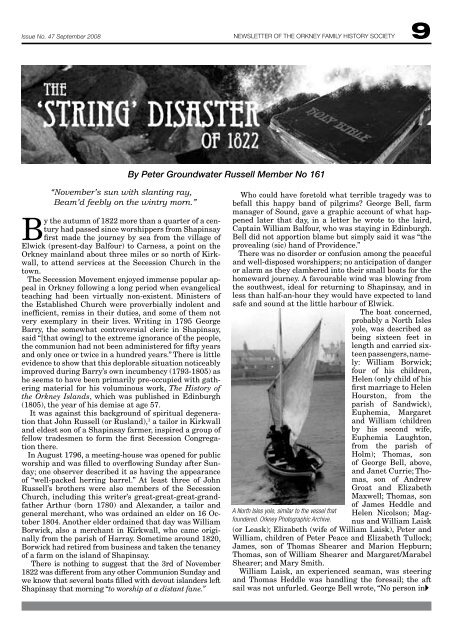SIB FOLK NEWS - Orkney Family History Society
SIB FOLK NEWS - Orkney Family History Society
SIB FOLK NEWS - Orkney Family History Society
You also want an ePaper? Increase the reach of your titles
YUMPU automatically turns print PDFs into web optimized ePapers that Google loves.
Issue No. 47 September 2008 <strong>NEWS</strong>LETTER OF THE ORKNEY FAMILY HISTORY SOCIETY 9<br />
“November’s sun with slanting ray,<br />
Beam’d feebly on the wintry morn.”<br />
By the autumn of 1822 more than a quarter of a century<br />
had passed since worshippers from Shapinsay<br />
first made the journey by sea from the village of<br />
Elwick (present-day Balfour) to Carness, a point on the<br />
<strong>Orkney</strong> mainland about three miles or so north of Kirkwall,<br />
to attend services at the Secession Church in the<br />
town.<br />
The Secession Movement enjoyed immense popular appeal<br />
in <strong>Orkney</strong> following a long period when evangelical<br />
teaching had been virtually non-existent. Ministers of<br />
the Established Church were proverbially indolent and<br />
inefficient, remiss in their duties, and some of them not<br />
very exemplary in their lives. Writing in 1795 George<br />
Barry, the somewhat controversial cleric in Shapinsay,<br />
said “[that owing] to the extreme ignorance of the people,<br />
the communion had not been administered for fifty years<br />
and only once or twice in a hundred years.” There is little<br />
evidence to show that this deplorable situation noticeably<br />
improved during Barry’s own incumbency (1793-1805) as<br />
he seems to have been primarily pre-occupied with gathering<br />
material for his voluminous work, The <strong>History</strong> of<br />
the <strong>Orkney</strong> Islands, which was published in Edinburgh<br />
(1805), the year of his demise at age 57.<br />
It was against this background of spiritual degeneration<br />
that John Russell (or Rusland), 1 a tailor in Kirkwall<br />
and eldest son of a Shapinsay farmer, inspired a group of<br />
fellow tradesmen to form the first Secession Congregation<br />
there.<br />
In August 1796, a meeting-house was opened for public<br />
worship and was filled to overflowing Sunday after Sunday;<br />
one observer described it as having the appearance<br />
of “well-packed herring barrel.” At least three of John<br />
Russell’s brothers were also members of the Secession<br />
Church, including this writer’s great-great-great-grandfather<br />
Arthur (born 1780) and Alexander, a tailor and<br />
general merchant, who was ordained an elder on 16 October<br />
1804. Another elder ordained that day was William<br />
Borwick, also a merchant in Kirkwall, who came originally<br />
from the parish of Harray. Sometime around 1820,<br />
Borwick had retired from business and taken the tenancy<br />
of a farm on the island of Shapinsay.<br />
There is nothing to suggest that the 3rd of November<br />
1822 was different from any other Communion Sunday and<br />
we know that several boats filled with devout islanders left<br />
Shapinsay that morning “to worship at a distant fane.”<br />
By Peter Groundwater Russell Member No 161<br />
Who could have foretold what terrible tragedy was to<br />
befall this happy band of pilgrims? George Bell, farm<br />
manager of Sound, gave a graphic account of what happened<br />
later that day, in a letter he wrote to the laird,<br />
Captain William Balfour, who was staying in Edinburgh.<br />
Bell did not apportion blame but simply said it was “the<br />
provealing (sic) hand of Providence.”<br />
There was no disorder or confusion among the peaceful<br />
and well-disposed worshippers; no anticipation of danger<br />
or alarm as they clambered into their small boats for the<br />
homeward journey. A favourable wind was blowing from<br />
the southwest, ideal for returning to Shapinsay, and in<br />
less than half-an-hour they would have expected to land<br />
safe and sound at the little harbour of Elwick.<br />
The boat concerned,<br />
probably a North Isles<br />
yole, was described as<br />
being sixteen feet in<br />
length and carried sixteen<br />
passengers, namely:<br />
William Borwick;<br />
four of his children,<br />
Helen (only child of his<br />
first marriage to Helen<br />
Hourston, from the<br />
parish of Sandwick),<br />
Euphemia, Margaret<br />
and William (children<br />
by his second wife,<br />
Euphemia Laughton,<br />
from the parish of<br />
Holm); Thomas, son<br />
of George Bell, above,<br />
and Janet Currie; Thomas,<br />
son of Andrew<br />
Groat and Elizabeth<br />
Maxwell; Thomas, son<br />
A North Isles yole, similar to the vessel that<br />
foundered. <strong>Orkney</strong> Photographic Archive.<br />
of James Heddle and<br />
Helen Nicolson; Magnus<br />
and William Laisk<br />
(or Leask); Elizabeth (wife of William Laisk), Peter and<br />
William, children of Peter Peace and Elizabeth Tullock;<br />
James, son of Thomas Shearer and Marion Hepburn;<br />
Thomas, son of William Shearer and Margaret/Marabel<br />
Shearer; and Mary Smith.<br />
William Laisk, an experienced seaman, was steering<br />
and Thomas Heddle was handling the foresail; the aft<br />
sail was not unfurled. George Bell wrote, “No person inA



